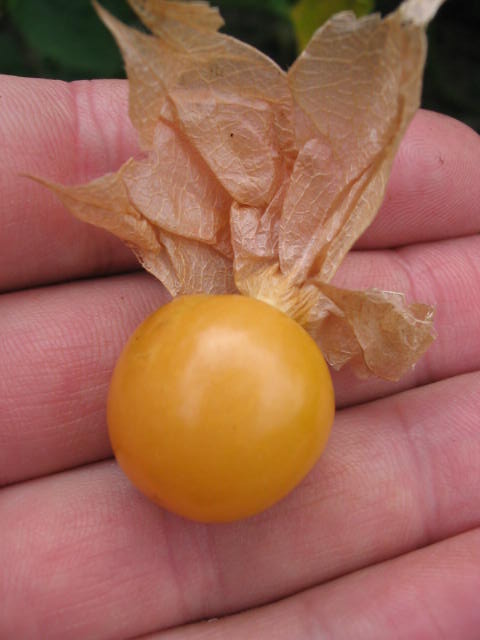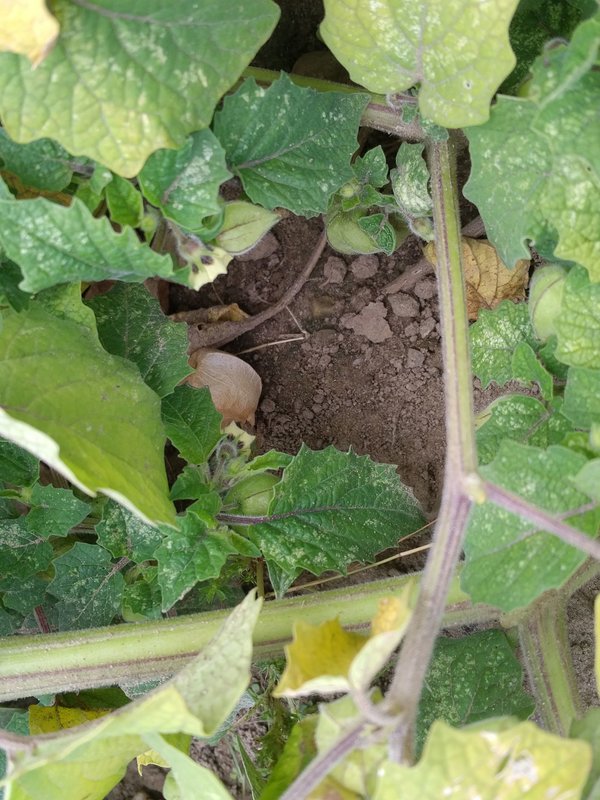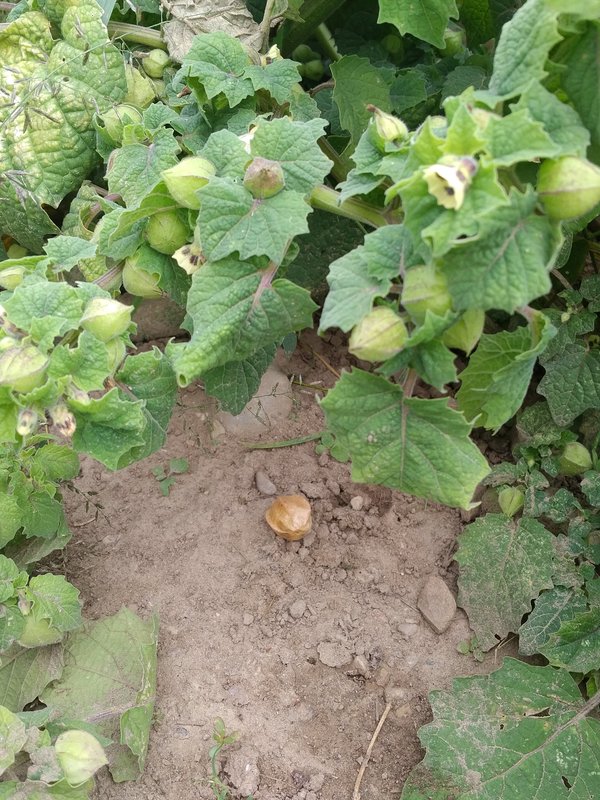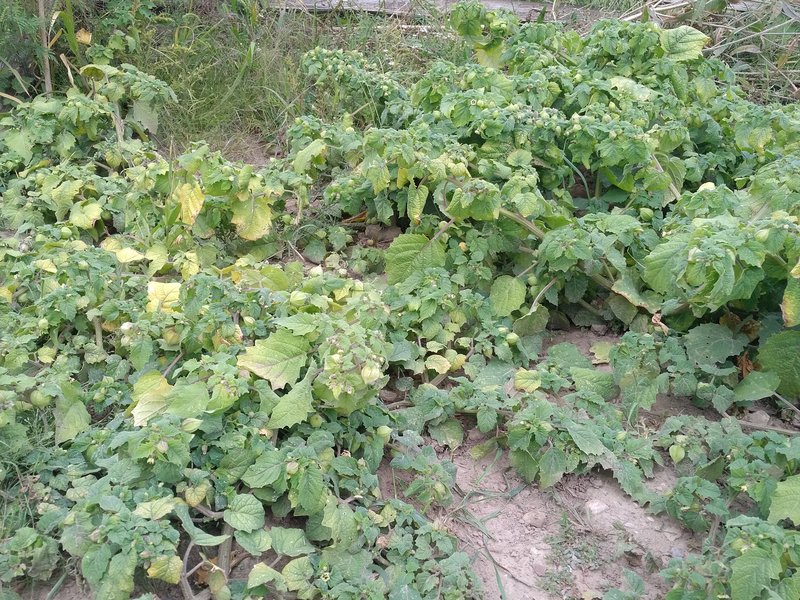Help Breed a Better Ground Cherry

This article is part of our 2020 Ground Cherry Breeding Project. If you would like to participate in 2021, look for our notice next winter.
Ground cherries are a delicious fruit that is easy to grow but not very well known. The small, golden berries have a taste that reminds some people of citrus or pineapple, and each berry comes individually wrapped in its own papery husk. The plants grow with little care once the tiny seeds are started, and suffer little damage from pests. Just a few plants can produce enough berries for a good dessert, and they bear all the way until frost.
One of the main reasons why ground cherries might not be so popular is that they're difficult to harvest. They're called ground cherries because they fall to the ground when ripe, and since each berry is wrapped in its own paper husk they can be harvested just by picking them up. This is time-consuming, however, because the berries hide below the plants so they're hard to find. Harvest usually involves crouching and peeking under the plants, lifting a branch with one hand while searching for fallen berries with the other. The plants are productive, but it can take a long time just to fill a bowl.
During the past few years, we noticed that some plants grow taller and more erect than others, and those were easier and faster to harvest because the berries on the ground could be seen and reached more easily. By saving seeds from those taller, erect plants we made the first step toward breeding a strain of ground cherries that (we hope) will be easier and faster to pick, and (we hope) more popular with growers.

Ripe ground cherries beneath low-growing plants are hard to find.

Ground cherries beneath tall-growing plants are easy to see and pick up.
This year, 52 of our members are growing plants from those selected seeds, and following the directions below. Their improved seeds will be available for all our members next year, to grow and continue to improve.
Which ground cherry is which?
There are several species and varieties of Physalis called "ground cherries" and their names are inconsistent and contradictory. Since this fruit is not as well known, nor as universally grown as other crops, different growers and even seed companies use different names for the same varieties, and the same names for different varieties. Despite our best effort to sort out the terminology, we had to concede that names will just confuse the process.
To try to be clear, we are focusing this project on the 1/2 inch pineapple-citrus-flavoured kind of ground cherry that ripens to lemon yellow (not the orange kind, not the larger kinds, and not the kinds that are usually used for salsa).
If we ever figure out a name to call them that won't add to confusion, that will certainly make this part easier.
Wait, you say they taste good? (read this if you disagree)
Another reason why ground cherries might not be so popular is that they only taste good when they are fully ripe. If you've grown them before and given up because they tasted bitter or earthy, you probably just tried them too soon.
Ground cherries are similar to tomatoes and peppers: when they ripen from green to yellow they produce most of their sugar and flavour during the last few days of ripening. They also start with an astringent, bitter flavour that goes away during the last stages of ripening. In short, ground cherries with a little green colour taste quite awful - you have to get them fully yellow.
Even though they fall from the plants when ripe, the berries harvested from the ground can still be a little under-ripe. Look at each one carefully for signs of green colour, and let them ripen in open air for a few more days. Ground cherries keep very well without refrigeration (in or out of their wrappers) so some gardeners simply harvest them into a bucket or bowl and let them all sit at room temperature for up to a week before removing the paper husks and enjoying the sweet -- fully ripe -- flavour.
How to Breed a Better Ground Cherry

The plant on the left has branches that almost touch the ground. The plant on the right is shaped more like a tree with branches up tall. Collect berries that fall from the tall plants, and keep their seeds.
Plant breeding is 5% specialized knowledge and 95% careful observation. This project takes a simple, common sense approach to selecting a ground cherry strain that stands tall and erect: save seeds from the plants that stand tall and erect, so next year more of them will do that.
Our first generation of selected ground cherries had a mixture of tall and short plants. The tall stems had branches that barely touched the ground, so the fallen berries were easy to find. The short plants basically laid on the ground making it impossible to see, let alone pick up, the husks that had separated.
All we did was to collect ground cherries that had fallen from the tall plants, and save those seeds for you to grow and repeat that selection.
1. Start ground cherry seeds similarly to tomatoes or peppers. They are small seeds so they have to be started indoors any time between late February and early April. The seedlings are damaged by frost, so plant out when all danger of cold weather has passed, the same as you would do for peppers.
2. The seeds need warmth to germinate. They will not germinate promptly in a room cooler than 20 degrees C, so place seed trays on a heater, in direct sunlight, or in a warm location. Once the seeds have started to sprout, they can be moved to a cooler place to continue growing.
3. Like tomatoes and peppers, ground cherries need little attention while they are growing up. Once they have flowers you will start to notice green husks, and eventually round green berries will grow inside them. By this time, you will be able to see which plants are tall and erect, and which are short and low-lying. In future years we will ask you to remove the low-growing plants, but in this early stage just let them grow. (* read more)
4. Around early August you will start to see ripe berries fall to the ground. Keep the soil clear of weeds and debris so that you can tell which berries have fallen from which plants. Your goal is to collect at least 20 ripe berries from the tall, erect plants. Pick up all the berries that fall from the low-growing plants, but just eat those. Try to collect the same number of berries from each of the tall plants, so your seeds come from an assortment of parents, but just the tall ones.
5. You can extract seeds from freshly picked ground cherries, or let the berries ripen for a week or longer to process more at a time. Remove the yellow berries from their husks and cut each one in half with a sharp knife. Immerse the cut berries in a bowl of water and squeeze out the seeds.
6. The seeds sink readily to the bottom of the bowl, and the berry pulp tends to float. In a short time, you'll have hundreds of clean seeds at the bottom of the bowl. There is no need to ferment ground cherry seeds, like tomato seeds. Just strain them from the water and let them dry on a plate.
7. Ground cherry seeds are very small, so if you spread them on a flat plate they should dry in open air in just a day or even a few hours. Avoid drying on paper towel, since they'll tend to stick to the paper. A smooth surface is easier.
8. When your saved seeds are dry, stir them to make sure that they're mixed up well and keep enough for you and your friends to plant next year. Send the rest to Seeds of Diversity so we can continue the breeding process with more people next year.
9. We can use as many seeds as you would like to send, but 20 berries is all we ask for. You'll have lots of ground cherries left to eat, so enjoy them!
(10). Next year, do it all again but notice that you should have more tall plants and fewer short plants. Does it make harvest easier and faster?
* And for the curious: why don't we want to remove the short plants?
If we're trying to eliminate the short plants, why keep them and allow them to cross with the tall plants? If your intuition tells you that ground cherries will cross-pollinate, so the seeds you collect (from the tall plants) will contain genes from the short plants, then you're completely correct. The reason we actually want that, at least initially, is to prevent "bottle-necking" the genetics of our new strain. It's still very early in the process, and there are only a relatively small number of really erect plants in the breeding population. That means if we only take seeds from those few individuals, we risk losing a wealth of healthy genes that might only be present in the others. For the first few generations, we want some crossing from the shorter plants, until the majority of the population becomes tall and erect. Then we can assume that the tall plants are sufficiently diverse to represent a healthy genetic sample, and only then can we ruthlessly rogue out the short plants. Only time will tell how many generations that will take, but it's probably fewer than most people would guess. Let's guess 3-4 generations, and in 2024 we'll see if we're right.
Not yet a member?
An annual membership to Seeds of Diversity gives you access to our seed exchange, seed grow-out programs, and our online news.

We depend on donations to do our work.

Thank you for your support!
